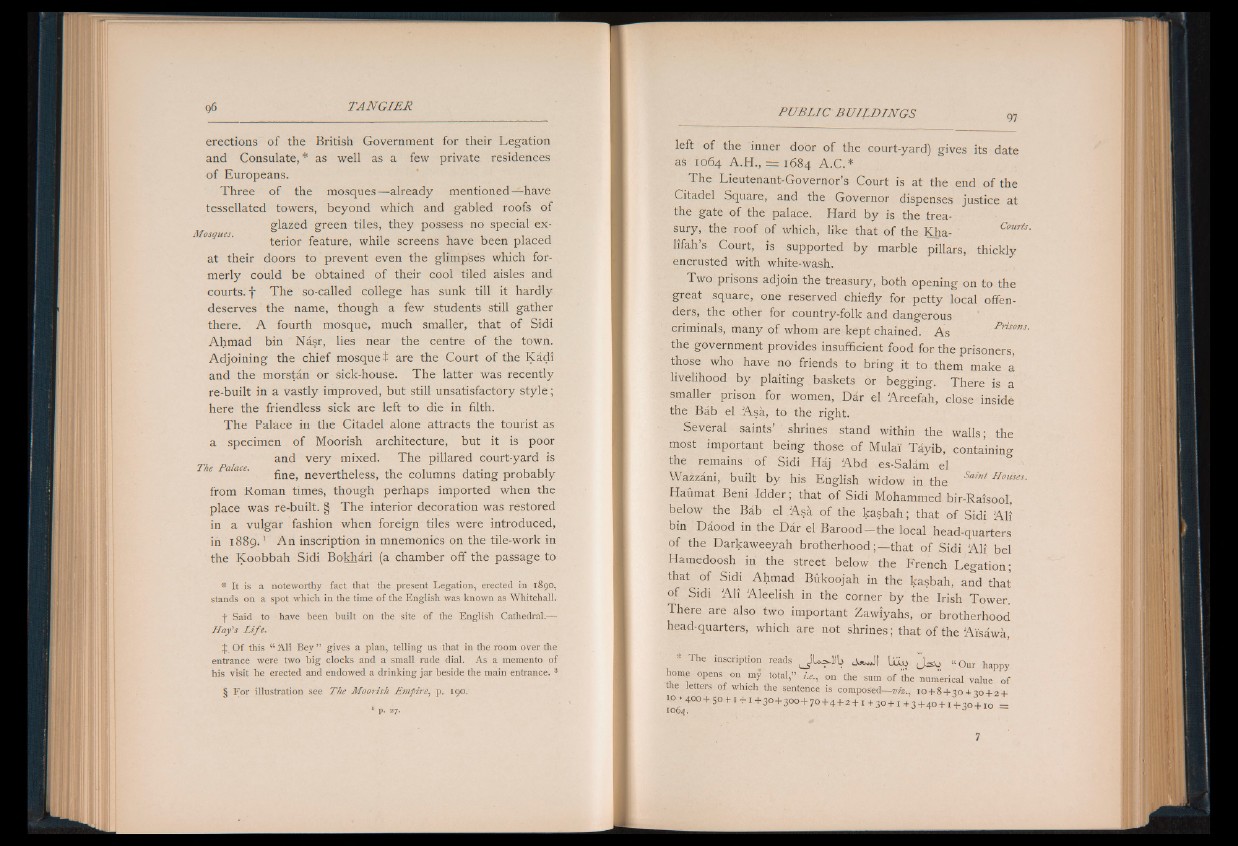
erections of the British Government for their Legation
and Consulate,* as well as a few private residences
of Europeans.
Three of the mosques—already mentioned— have
tessellated towers, beyond which and gabled roofs of
glazed green tiles, they possess no special exterior
feature, while screens have been placed
at their doors to prevent even the glimpses which formerly
could be obtained o f their cool tiled aisles and
courts, f The so-called college has sunk till it hardly
deserves the name, though a few students still gather
there. A fourth mosque, much smaller, that of Sidi
Ahmad bin Nasr, lies near the centre of the town.
Adjoining the chief mosque t are the Court of the Kadi
and the morstan or sick-house. The latter was recently
re-built in a vastly improved, but still unsatisfactory s ty le ;
here the friendless sick are left to die in filth.
The Palace in the Citadel alone attracts the tourist as
a specimen of Moorish architecture, but it is poor
and very mixed. The pillared court-yard is
fine, nevertheless, the columns dating probably
from Roman times, though perhaps imported when the
place was re-built. § The interior decoration was restored
in a vulgar fashion when foreign tiles were introduced,
in 1889.1 A n inscription in mnemonics on the tile-work in
the Koobbah Sidi Bokhari (a chamber off the passage to
* It is a noteworthy fact that the present Legation, erected in 1890,
stands on a spot which in the time of the English was known as Whitehall.
t Said to have been built on the site of the English Cathedral.—
Hay's L ife .
f; Of this “ Alt Bey ” gives a plan, telling us that in the room over the
entrance were two big clocks and a small rude dial. As a memento of
his visit he erected and endowed a drinking jar beside the main entrance. 8
left of the inner door of the court-yard) gives its date
as 1064 A.H., = 1684 A .C .*
The Lieutenant-Governor’s Court is at the end of the
Citadel Square, and the Governor dispenses justice at
the gate of the palace. Hard by is the treasury,
the roof of which, like that of the Kha- Courts.
lifah’s Court, is supported by marble pillars, thickly
encrusted with white-wash.
Two prisons adjoin the treasury, both opening on to the
great square, one reserved chiefly for petty local offenders,
the other for country-folk and dangerous
criminals, many of whom are kept chained. A s Pnsons.
the government provides insufficient food for the prisoners,
those who have no friends to bring it to them make a
livelihood by plaiting baskets or begging. There is a
smaller prison for women, Dar el Areefah, close inside
the Bab el Asa, to the right.
Several saints’ shrines stand within the walls; the
most important being those of Mulai Tayib, containing
the remains o f Sidi Haj Abd es-Salam el
Wazzani, built by his English widow in the | § l Hoiises-
Haumat Beni Idder; that of Sidi Mohammed bir-Raisool,
below the Bab el Asa of the kasbah; that o f Sidi A li
bin Daood in the Dar el B a ro o d -th e local head-quarters
of the Darkaweeyah brotherhood ¡— that o f Sidi A li bel
Hamedoosh iii the street below the French Legation;
that of Sidi Ahmad Bukoojah in the kasbah, and that
of Sidi A li Aleelish in the corner by the Irish Tower.
There are also two important Zawiyahs, or brotherhood
head-quarters, which are not shrines; that of the Ai'sawa,
* The inscription reads J * j | liiu J s v j «Our happy
home opens on my total,” i.e., on the sum of'the numerical value of
he letters of which the sentence is composed—viz., 10 + 8+30 + 30+2 +
^*400 + 50 + 1 + 1+30+300+ 70+4 + 2 + 1+30 + 1 +3+40 + 1+30 + 10 =